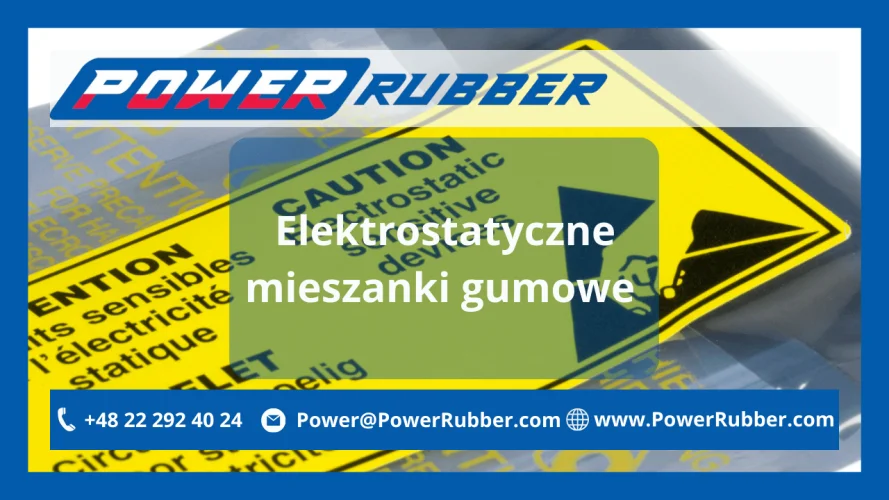Electrostatic rubber blends
Static electricity is a serious problem in industrial environments – from damaging sensitive electronic components to increasing the risk of explosion. It arises when two materials or surfaces come into contact, rub against each other, or are separated, causing a transfer of electrons.
Transport of materials, movement of conveyor belts, mixing powders, unwinding foils – these are just some processes that contribute to the rapid accumulation of electrostatic charges. Uncontrolled static electricity can lead to serious consequences in industrial environments, including equipment failures, product damage, increased fire hazard, and a decrease in the efficiency of production processes.
Why is electrostatic control so important?
In an industrial environment, electrostatic control plays a key role in ensuring safety, high quality, and continuity of production. Although electrostatic charges may seem harmless at first glance, their uncontrolled occurrence can in reality lead to serious threats.
Static electricity - an invisible threat
Electrostatic discharge occurs when electrical charges accumulate on the surface of a material, which can cause sparking or attract dust particles. In some environments, the accumulation of electrostatic charges can be dangerous. Even a small spark can lead to serious consequences:
- damage to sensitive electronic components and devices (ESD)
- explosions in potentially explosive atmospheres (ATEX)
- disruption of device operation
Static electricity poses a huge danger in environments where flammable substances such as gases, vapors, or powders are present. Static discharges can cause sparking, which can ignite gaseous and liquid fuels. Even a single spark can initiate ignition and consequently lead to a fire or explosion, e.g., in grain transshipment facilities or paint booths.
Even the smallest, sudden electrostatic discharges (ESD) can damage electrically sensitive equipment such as semiconductors and integrated circuits. Electrostatic charges also attract dust particles and various types of contamination, which can result in the contamination of food or pharmaceutical packaging lines, negatively affecting product quality and increasing the number of rejected batches.
Controlling static electricity not only affects product quality but is also essential for maintaining operator safety in the workplace and minimizing problems with process equipment. It is worth remembering that the level of risk associated with electrostatics varies depending on the specific industrial environment.
What are electrostatic rubber compounds?
Electrostatic rubber compounds are technologically advanced polymer compositions that combine the properties of classic elastomers with the ability to protect against electrostatic discharges. Their use is crucial for safety in various industries in areas where electrostatics can pose threats to people, sensitive devices, equipment, and technological processes.
Antistatic additives for rubber
To standard rubber compounds, such as
Special conductive or dissipative additives, such as carbon fibers or carbon nanotubes, are added. These play an important role in improving the material's properties. Antistatic additives added to rubber are used to reduce the accumulation of electrostatic charges on its surface. The material is characterized by excellent electrical conductivity and the ability to dissipate electrostatic charges. Additives also help maintain the cleanliness of rubber products, preventing, among other things, the deposition of dust and other particles on their surfaces. It is worth mentioning that electrostatic rubber compounds, thanks to appropriate modification of their composition, can be adjusted in terms of hardness, mechanical strength, and flexibility, which allows for their wide application in various industries.

Properties of electrostatic rubber compounds
The primary feature of electrostatic rubber compounds is electrostatic conductivity, i.e., the ability to controllably dissipate electrostatic charges. ESD rubber has the ability to dissipate and conduct electrostatic charges and prevent their accumulation on the workpiece.
At Power Rubber, electrostatic rubber compounds have been designed for intensive use. They are resistant to abrasion, stretching, and cracking. High quality directly contributes to a longer service life and reduced wear. The hardness of the rubber compound can be precisely adjusted to technical requirements and the working environment.
Depending on the base used (e.g., NBR, SBR), the compounds, in addition to antistatic protection, are characterized by resistance to oils, petroleum derivatives, acids, solvents, or high temperatures. This makes them an ideal solution in harsh industrial conditions.
Application of electrostatic rubber compounds
The unique properties of electrostatic rubber compounds mean that they are used wherever ESD control is a priority. Their composition is adapted to specific operating requirements, such as chemical, temperature, or mechanical resistance. They find application in areas such as:
- electronic and electrical industry - rubber compounds are used for antistatic mats on workbenches, floors, conveyor belts, cable and hose covers. Rubber products with antistatic properties work perfectly, for example, in factories producing integrated circuits or microcontrollers;
- automotive and aerospace industry - electrostatic compounds are used for the production of gaskets, wires, seals for valves and pumps, coatings preventing the accumulation of charges that could disrupt the operation of automotive electronics
- chemical and petrochemical industry - production of chemical-resistant and charge-accumulating resistant wires and seals;
- mining - rubber compounds with antistatic additives are used for the production of conveyor belt elements and seals protecting against sparking in explosive atmospheres;
- medical and pharmaceutical industry - used in clean rooms, where it is important to maintain a clean and stable production environment, and in devices that require electrostatic control, e.g., to avoid contamination and dust particles;
- industrial equipment - in devices used for transporting bulk materials (rubber belts, elements of conveyor systems in explosive atmospheres);
- facilities processing flammable substances - handling explosives and chemicals
- EX zones (explosion hazard)
Rubber products from electrostatic compounds available at Power Rubber store
At the Power Rubber store, we offer high-quality rubber products made from electrostatic compounds, intended for professional applications in various industries, laboratories, and wherever there is a risk of electrostatic discharge.
In our offer you will find, among others:
Why use electrostatic rubber from Power Rubber? - Key benefits
At Power Rubber, we produce ESD rubber products that help control static electricity. They effectively prevent the accumulation of electrostatic charges that can permanently damage sensitive electronic components. What's more, they also reduce the risk of electrostatic discharges, which pose a direct threat to people and property in industrial environments, and also increase safety in workplaces by reducing the risk of sparking, which can cause fire or explosion.
If you are looking for ESD protection that enables rapid and controlled dissipation of electrical charges, please contact us by phone: +48 22 292 40 24 or +48 50 51 603 03, or at the given email address (power|powerrubber.com| rel="nofollow"|Power|PowerRubber.com) or via our contact form
